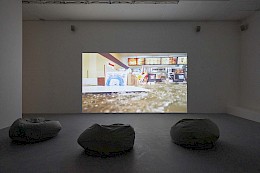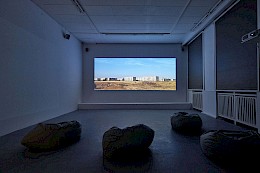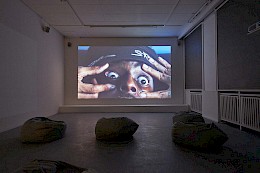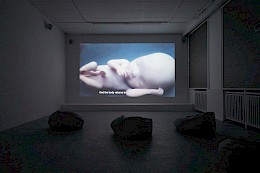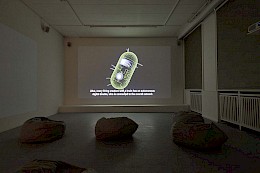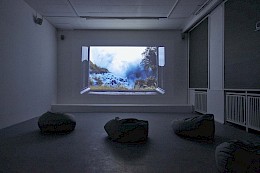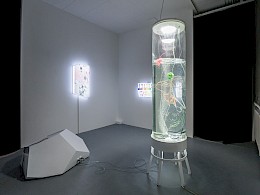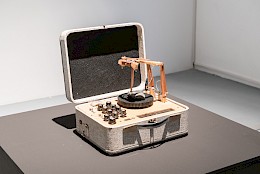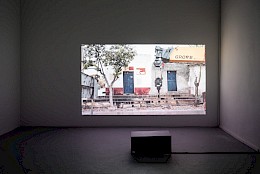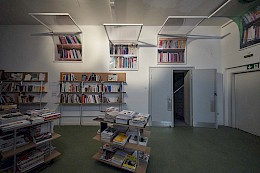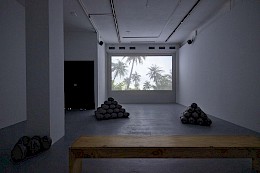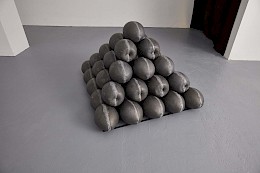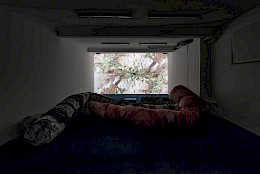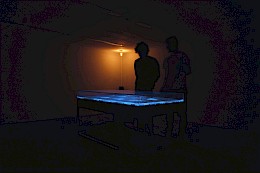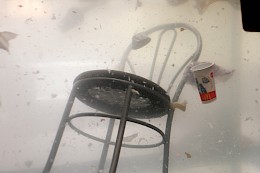Für den modernen Menschen erweist sich das Erleben bestimmter Szenarien oftmals als ein wirksames Medium zur Eröffnung neuer Perspektiven auf sich und seine Gegenwart. Anknüpfend daran erprobt die Ausstellung There Will Come Soft Rains (1) einen besonderen Erfahrungskontext, indem sie eine fiktive Zeitreise initiiert. Eine Gruppe von internationalen KünstlerInnen begibt sich hierbei in das Jahr 2318, wo sie auf eine neuartige Welt ohne menschliche Spezies trifft.
Ausgehend von diesem Zeitsprung untersuchen die KünstlerInnen Marcela Armas, Carolina Caycedo, Julian Charrière, Andreas Greiner & Tyler Friedman, Jeronimo Voss und Pinar Yoldas im Rahmen neu konzipierter Installationen die Eigenheiten einer non-humanen Welt. Orientiert sich das Ausstellungsdisplay in seiner Inszenierung von Themenräumen dabei in loser Weise an der typologischen Präsentationsform von Naturkundemuseen, so verkehrt die Ausstellung den darin üblicherweise vollzogenen Rückblick auf historische Epochen jedoch in einen spekulativen Ausblick auf die Zukunft. Darüber hinaus umfasst die Ausstellungssituation zugleich einen separaten Projektionsraum, in dem filmische Arbeiten von Hicham Berrada, Galina Leonova, Uriel Orlow, Mario Pfeifer und Superflex präsentiert werden. Das Filmprogramm nähert sich anhand aktueller Themen aus Ökologie, Gesellschaft und Politik in assoziativer Weise dem dystopischen Potenzial unserer Gegenwart an und erkundet damit die möglichen Ursachen für ein zukünftiges Verschwinden der Menschheit.
Grundlegende Fragestellungen zum Umgang mit unserer Umwelt, die Beziehung zwischen Kunst und Wissenschaft sowie das spätkapitalistische Selbstverständnis des Menschen bilden innerhalb der Ausstellung wiederkehrende Momente der künstlerischen Auseinandersetzungen. Durch spekulative und poetische Erweiterungen von existierenden Entwicklungen spüren die Arbeiten zugleich den tieferliegenden Verbindungslinien zwischen Zukunft und Gegenwart nach. Dadurch stellen sie die positiven wie auch negativen Einschreibungen einer möglichen Welt ohne Menschen zur Disposition.
Das anthropozentrische Denken der Vergangenheit setzt sich innerhalb unserer Gegenwart nicht zuletzt auf vielfältige Weise in den aktuellen Spekulationen über hybride Lebensformen und virtuelle Erweiterungen fort. Mit dem Szenario einer non-humanen Welt möchte die Ausstellung There Will Come Soft Rains über diesen Standpunkt hinausblicken. So wird das Konzept im selben Moment als eine offene Reflexion über Formen des Zusammenlebens abseits der menschlichen Dominanz lesbar. Doch welches alternative Denken über eine zukünftige Welt lässt sich durch die Negierung der menschlichen Perspektive anstoßen? Und sind darin neue Strukturen und Symbiosen vorstellbar, die als positiver Anknüpfungspunkt für den aktuellen Handlungshorizont des Einzelnen dienen?
1) Der Titel There Will Come Soft Rains referiert auf das gleichnamige Gedicht von Sara Teasdale, welches erstmals 1918 im Harper’s Magazine veröffentlicht wurde.
Exhibition View
Artists
Marcela Armas
>artwork >interview >website
Hicham Berrada
>artwork >website
Carolina Caycedo
>artwork >interview >website
Julian Charrière
>artwork >website
Tyler Friedman
>artwork
Andreas Greiner
>artwork >website
Galina Leonova
>artwork
Uriel Orlow
>artwork >interview >website
Mario Pfeifer
>artwork >interview >website
Jeronimo Voss
>artwork >interview
Pinar Yoldas
>artwork >interview
